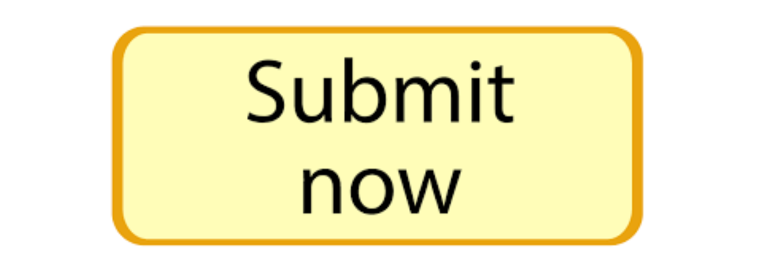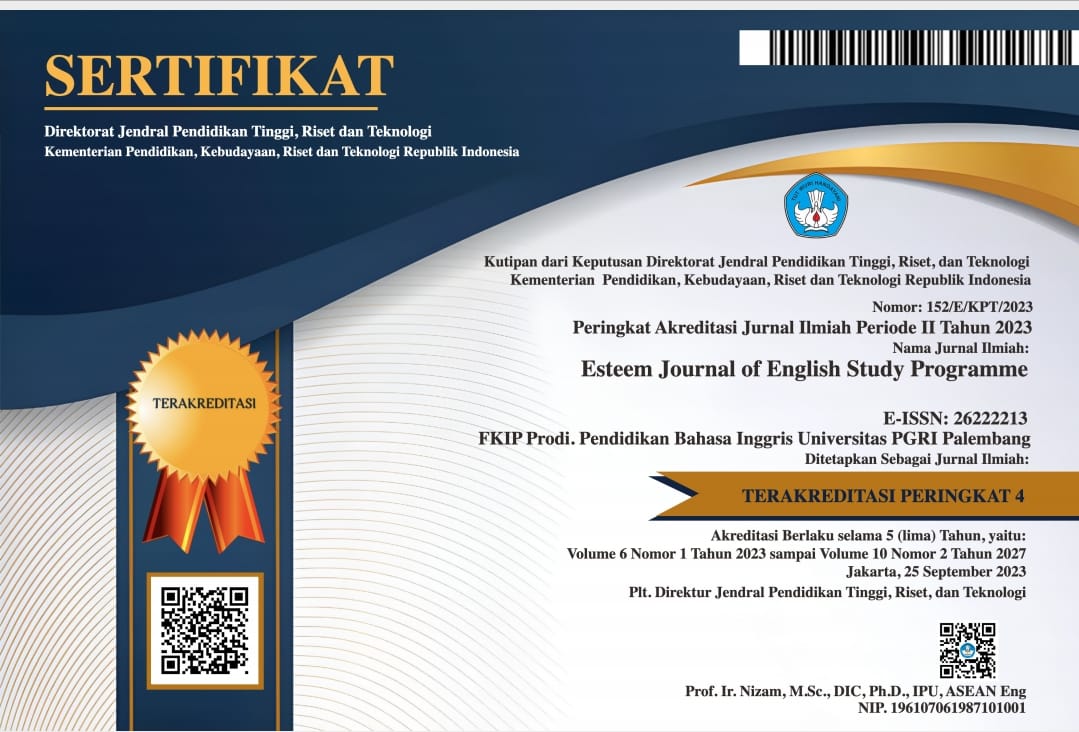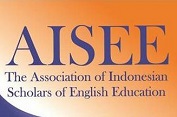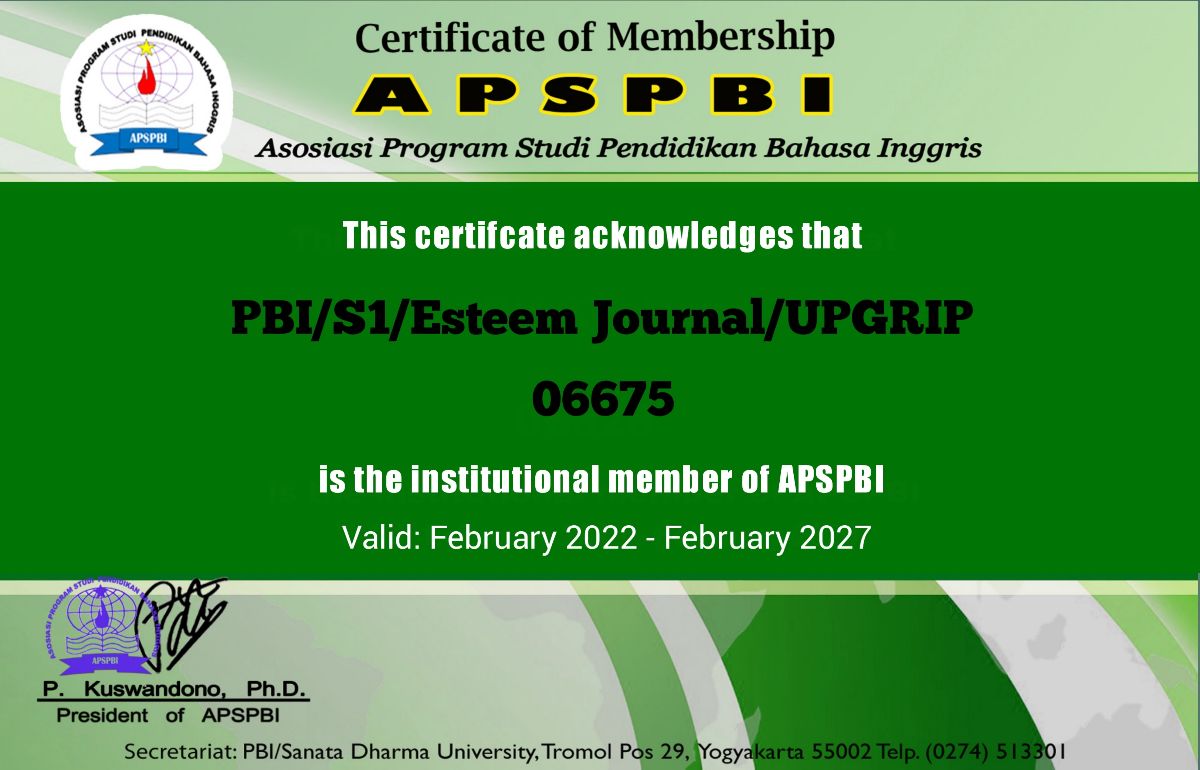FROM IMITATION TO EXPRESSION: THE USE OF DIRTY WORDS AMONG ELEMENTARY SCHOOL STUDENTS
DOI:
https://doi.org/10.31851/esteem.v8i1.18224Keywords:
Swear Words, Elementary School Student, Psycholinguistics, Dirty WordsAbstract
This study examines the use of harsh language by elementary school children at a public school in West Jakarta. A qualitative research approach, combining observation and interviews, was used to gather data from 20 participants. The aim was to gain a comprehensive understanding of the usage of offensive language in their environment. The findings reveal five categories of harsh language: Dyspeptic Swearing, Abusive Swearing, Idiomatic Swearing, Emphatic Swearing, and Cathartic Swearing. Additionally, several types of offensive language were identified, including Animal, Sex Organ, Sexual Activity, Scatological, Patronymic, Racial/Ethnic Insults, Ableism, and Body Shaming. The study also highlights that the usage of these offensive terms is influenced by neurological, psychological, and sociocultural factors. The results of this research provide valuable insights into the wide variety of harsh words used by elementary school children and emphasize the need for fostering the use of more positive language among students.
References
Arikunto, S. (2009). Metodelogi Penelitian. Bina Aksara.
Askhatova A. (2020). Pedagogical Sciences Importance of Vocabulary and Spoken Grammar in Teaching Spontaneous Speaking Skill. Sciences of Europe #, 49.
Adawiah, R., Marliana, R., Nasrah, N., & Husna, A. (2024). Positioning Youth in Maintaining the Mandarese Language. INSPIRING, 351-365.
American Psychological Association (2010). https://www.apa.org/pi/ses/resources/publications/children-families?
Bergen, B. K. (2016). What the F: What swearing reveals about our language, our brains, and ourselves. Basic Books.
Coyne, S. M., Stockdale, L., Nelson, D. A., & Fraser, A. M. (2011). Profanity in media associated with attitudes and behavior regarding profanity use and aggression. Pediatrics, 128(5), 867–872. https://doi.org/10.1542/peds.2011-1062
Common Sense Media. (2022). The Common Sense census: Media use by tweens and teens. Retrieved from https://www.commonsensemedia.org/research/the-common-sense-census-media-use-by-tweens-and-teens-2022
Creswell, J. W., & Creswell, J. D. (2017). Research design: Qualitative, quantitative, and mixed methods approaches. Sage publications.
Dash, B. B. (2022). Digital Tools for Teaching and Learning English Language in 21 st Century. International Journal Of English and Studies, 4(2), 8–13. http://dx.doi.org/10.47311/IJOES.2022.4202
Feldman, R. S., & Rime, B. (2020). The social dynamics of emotion: Origins and functions of emotional sharing. Cambridge University Press.
Fischer, M. H., Shaki, S., & Cruise, A. (2019). Social media and moral development: A cross-cultural study. Frontiers in Psychology, 10, 2823. https://doi.org/10.3389/fpsyg.2019.02823
Guardian News and Media. (2024, August 7). The language of hatred and legitimate anger. The Guardian. https://www.theguardian.com/politics/article/2024/aug/07/the-language-of-hatred-and-legitimate-anger
Gundlach, E. (2014). Family influence on children's language development. Language and Linguistics, 12(3), 56-72.
Jay, T. (1999). Why we curse: A neuro-psycho-social theory of speech. John Benjamins Publishing Company.
Kholisoh, M. N., & Linggar Bharati, D. A. (2021). Teachers’ questioning strategies and students’ perceptions toward critical questions in EFL classroom interaction. ELT Forum: Journal of English Language Teaching, 10(2), 136–145. https://doi.org/10.15294/elt.v10i2.43302
Kit, O., Kilag, T., Uy, F. T., Macapobre, K. A., Canonigo, K., Anrev, J., Pansacala, A., Flordelis, M., Cabaluna, R., & Calunsag, J. E. (2024). Exploring the Impact of Language Exposure on Students’ English Comprehension. International Multidisciplinary Journal of Research for Innovation, Sustainability, and Excellence (IMJRISE), 1(7), 85–91. https://doi.org/https://doi.org/10.5281/zenodo.12614542
Koole, S. L. (2009). The psychology of emotion regulation: An integrative review. Cognition and Emotion, 23(1), 4-41.
Kowert, R., Festl, R., & Quandt, T. (2014). Unpopular, overweight, and socially inept: Reconsidering the stereotype of online gamers. Cyberpsychology, Behavior, and Social Networking, 17(3), 141–146. https://doi.org/10.1089/cyber.2013.0118
Kowert, R., Domahidi, E., & Quandt, T. (2021). The relationship between online video game involvement and gaming-related friendships among emotionally sensitive individuals. Cyberpsychology, Behavior, and Social Networking, 24(1), 29–34.
Lesiana, N., Mulyadi, Aswadi Jaya, & Pratiwi, E. (2023). Classroom Interaction in Communicative Language Teaching of Secondary School. Esteem Journal of English Education Study Programme, 7(1), 61–71. https://doi.org/10.31851/esteem.v7i1.12661
Meyer, H. R. (2024). When Little Words Cause Big Problems: Handling Child Cursing. Retrieved from https://www.addrc.org/when-little-words-cause-big-problems-handling-child-cursing/
Rama, M. A., Hamdani, Z., & Prihatini, C. (2023). Students’ Perception On The Use Of Tiktok As An Effective Learning Media In Improving Students’ Vocabulary. Journal on Education. https://doi.org/https://doi.org/10.31004/joe.v5i4.4047
ResearchRaising Children Network. (n.d.). Swearing: School-age children. Raising Children Network. https://raisingchildren.net.au/school-age/behaviour/common-concerns/swearing
Rowell, T., & O'Brien, T. (2015). Children’s language development and peer influence: The socialization of swear words. Journal of Child Language, 42(6), 1-17.
Sari, A., Jaya, A., Hermansyah, H., & Mortini, A. V. (2022). Using Mixidea Online Debating Strategy To Promote the Students’ Speaking Ability. Esteem Journal of English Education Study Programme, 5(2), 298–303. https://doi.org/10.31851/esteem.v5i2.8591
Sarrett, J. (2023). Language matters: Ableism in everyday language. Medium. https://sarrettspeaks.medium.com/language-matters-ableism-in-everyday-language-1fc18b374b2d
Setyawan, A., Suhardiyanto, T., & Darmojuwono, S. (2020, June). Collocation and Connotation of Indonesian Word Hitam (Black). In Proceedings of the Third International Seminar on Recent Language, Literature, and Local Culture Studies, BASA, 20-21 September 2019, Surakarta, Central Java, Indonesia.
Stephens, R., & Umland, C. (2011). Swearing as a response to pain—Effect of daily swearing frequency. The Journal of Pain, 12(12), 1274–1281. https://www.ncbi.nlm.nih.gov/pmc/articles/PMC3261197/
Suganob-Nicolau, M. F. (2016). Swear words among young learners: A case study of the elementary students. Indonesian JELT: Indonesian Journal of English Language Teaching, 11(2), 117-132.
Simpson, E. (2016). When Moms Say Bad Words: Family and Peer Influence on the Frequency of Swearing.
Tatar, M. (2016). Swearing and media: The role of pop culture in language evolution. Communication Studies, 25(4), 167-182.
Tompkins, T., Lynch, M., & Peres, S. C. (2020). The impact of multiplayer online games on adolescent communication skills. Computers in Human Behavior, 105, 106190. https://doi.org/10.1016/j.chb.2019.106190
Wang, Y., & Miller, S. (2019). The relationship between emotion regulation and aggression: A meta-analytic review. Aggression and Violent Behavior, 47, 74-85.
Zulkifli, N. N., Letchumanan, M., Kamarudin, S., Halim, N. D. A., & Hashim, S. (2022). A Review: The Effectiveness of Using TikTok in Teaching and Learning. International Conference on Computers in Education.
Downloads
Published
Issue
Section
License
Copyright (c) 2025 Shania Nabillah Putri, Aliza Amelia Safitri, Dhuha Hadiyansyah

This work is licensed under a Creative Commons Attribution-NonCommercial-ShareAlike 4.0 International License.
Copyright Notice
Authors who publish with this journal agree to the following terms:
In order to assure the highest standards for published articles, a peer review policy is applied. In pursue of the compliance with academic standards, all parties involved in the publishing process (the authors, the editors and the editorial board and the reviewers) agree to meet the responsibilities stated below in accordance to the Journal publication ethics and malpractice statement.
Duties of Authors:
- The author(s) warrant that the submitted article is an original work, which has not been previously published, and that they have obtained an agreement from any co-author(s) prior to the manuscript’s submission;
- The author(s) should not submit articles describing essentially the same research to more than one journal;
- The authors(s) make certain that the manuscript meets the terms of the Manuscript Submission Guideline regarding appropriate academic citation and that no copyright infringement occurs;
- The authors(s) should inform the editors about any conflict of interests and report any errors they subsequently, discover in their manuscript.
Duties of Editors and the Editorial Board:
- The editors, together with the editorial board, are responsible for deciding upon the publication or rejection of the submitted manuscripts based only on their originality, significance, and relevance to the domains of the journal;
- The editors evaluate the manuscripts compliance with academic criteria, the domains of the journal and the guidelines;
- The editors must at all times respect the confidentiality of any information pertaining to the submitted manuscripts;
- The editors assign the review of each manuscript to two reviewers chosen according to their domains of expertise. The editors must take into account any conflict of interest reported by the authors and the reviewers.
- The editors must ensure that the comments and recommendations of the reviewers are sent to the author(s) in due time and that the manuscripts are returned to the editors, who take the final decision to publish them or not.
Authors are permitted and encouraged to post online a pre-publication manuscript (but not the Publisher final formatted PDF version of the Work) in institutional repositories or on their Websites prior to and during the submission process, as it can lead to productive exchanges, as well as earlier and greater citation of published work (see The Effect of Open Access). Any such posting made before acceptance and publication of the Work shall be updated upon publication to include a reference to the Publisher-assigned DOI (Digital Object Identifier) and a link to the online abstract for the final published Work in the Journal.





























